Management Improvement in Service Quality: Sofitel Wentworth Hotel
VerifiedAdded on 2023/03/30
|36
|7228
|144
Report
AI Summary
This report presents a case study on the Sofitel Wentworth Hotel in Sydney, focusing on improving service quality to maximize guest satisfaction, particularly concerning the banquet services. The research investigates the reasons behind customer dissatisfaction, identifies key areas for improvement, and proposes actionable recommendations. The study employs a qualitative approach, including an interview with a front desk supervisor and analysis of online reviews, to understand guest perceptions. The literature review explores the importance of service quality, dimensions of service, measurements, and improvement strategies. The findings highlight the significance of staff interactions, physical facilities, and food and beverage quality in shaping customer experiences and loyalty. The report concludes with specific recommendations for the hotel to enhance its service offerings and foster greater customer satisfaction, loyalty, and a positive brand image.
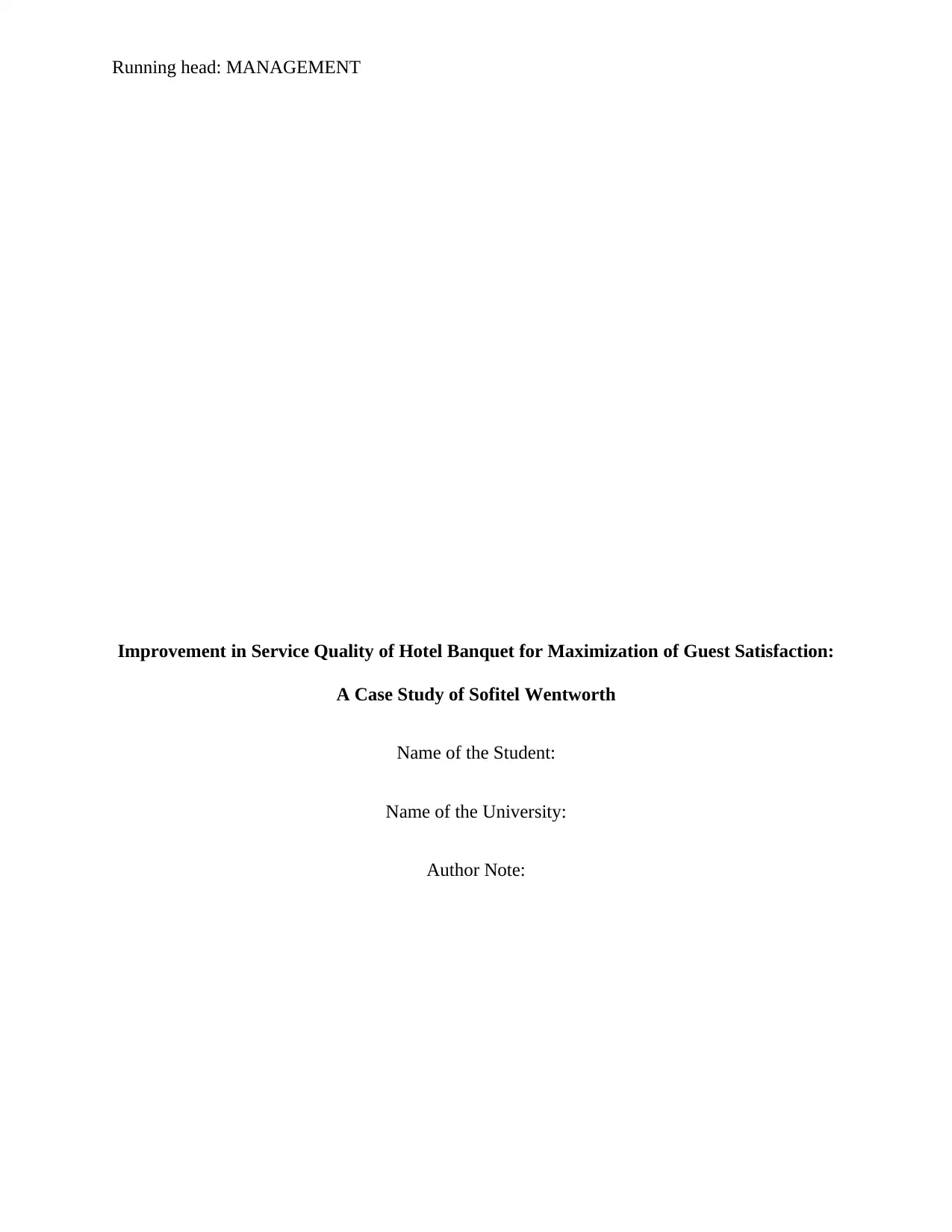
Running head: MANAGEMENT
Improvement in Service Quality of Hotel Banquet for Maximization of Guest Satisfaction:
A Case Study of Sofitel Wentworth
Name of the Student:
Name of the University:
Author Note:
Improvement in Service Quality of Hotel Banquet for Maximization of Guest Satisfaction:
A Case Study of Sofitel Wentworth
Name of the Student:
Name of the University:
Author Note:
Paraphrase This Document
Need a fresh take? Get an instant paraphrase of this document with our AI Paraphraser
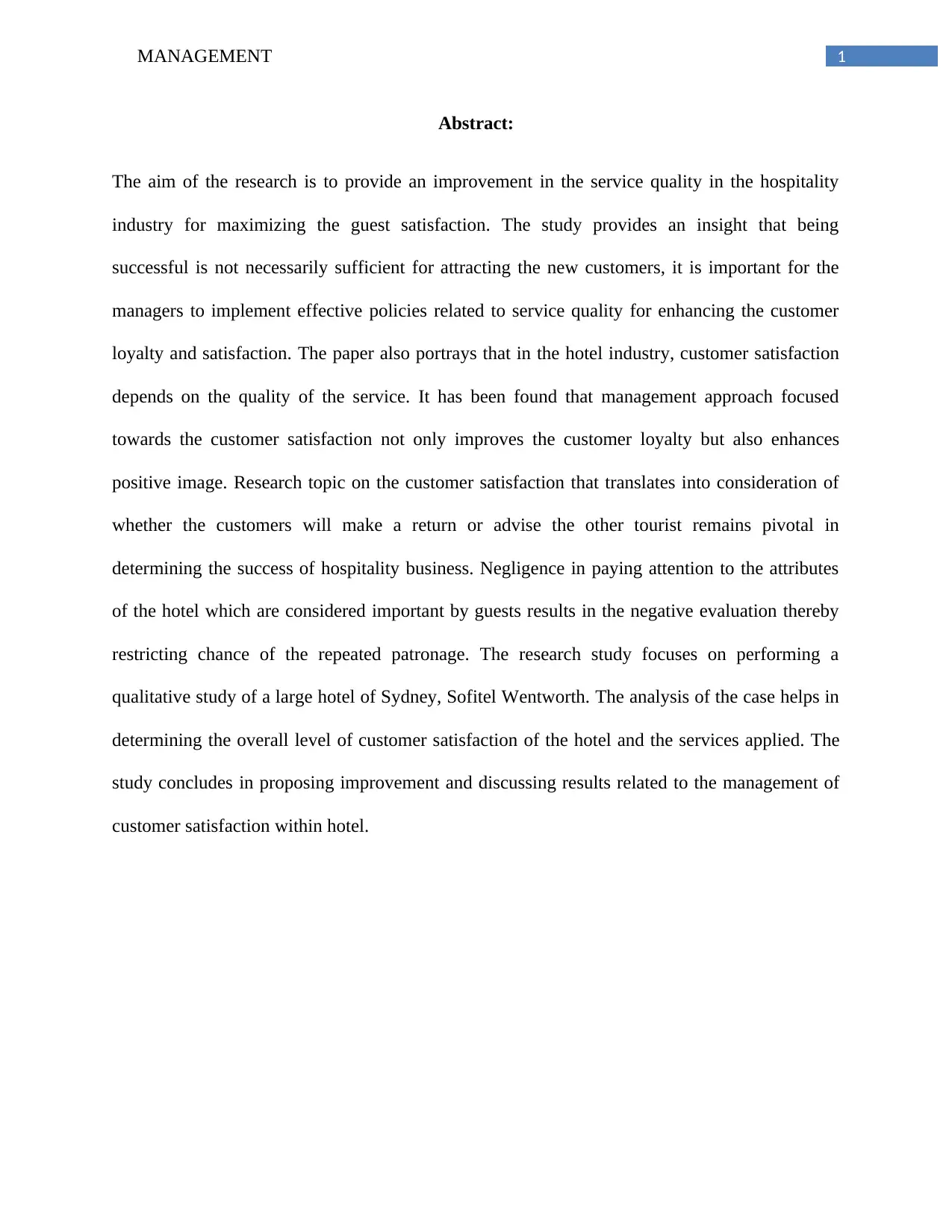
1MANAGEMENT
Abstract:
The aim of the research is to provide an improvement in the service quality in the hospitality
industry for maximizing the guest satisfaction. The study provides an insight that being
successful is not necessarily sufficient for attracting the new customers, it is important for the
managers to implement effective policies related to service quality for enhancing the customer
loyalty and satisfaction. The paper also portrays that in the hotel industry, customer satisfaction
depends on the quality of the service. It has been found that management approach focused
towards the customer satisfaction not only improves the customer loyalty but also enhances
positive image. Research topic on the customer satisfaction that translates into consideration of
whether the customers will make a return or advise the other tourist remains pivotal in
determining the success of hospitality business. Negligence in paying attention to the attributes
of the hotel which are considered important by guests results in the negative evaluation thereby
restricting chance of the repeated patronage. The research study focuses on performing a
qualitative study of a large hotel of Sydney, Sofitel Wentworth. The analysis of the case helps in
determining the overall level of customer satisfaction of the hotel and the services applied. The
study concludes in proposing improvement and discussing results related to the management of
customer satisfaction within hotel.
Abstract:
The aim of the research is to provide an improvement in the service quality in the hospitality
industry for maximizing the guest satisfaction. The study provides an insight that being
successful is not necessarily sufficient for attracting the new customers, it is important for the
managers to implement effective policies related to service quality for enhancing the customer
loyalty and satisfaction. The paper also portrays that in the hotel industry, customer satisfaction
depends on the quality of the service. It has been found that management approach focused
towards the customer satisfaction not only improves the customer loyalty but also enhances
positive image. Research topic on the customer satisfaction that translates into consideration of
whether the customers will make a return or advise the other tourist remains pivotal in
determining the success of hospitality business. Negligence in paying attention to the attributes
of the hotel which are considered important by guests results in the negative evaluation thereby
restricting chance of the repeated patronage. The research study focuses on performing a
qualitative study of a large hotel of Sydney, Sofitel Wentworth. The analysis of the case helps in
determining the overall level of customer satisfaction of the hotel and the services applied. The
study concludes in proposing improvement and discussing results related to the management of
customer satisfaction within hotel.
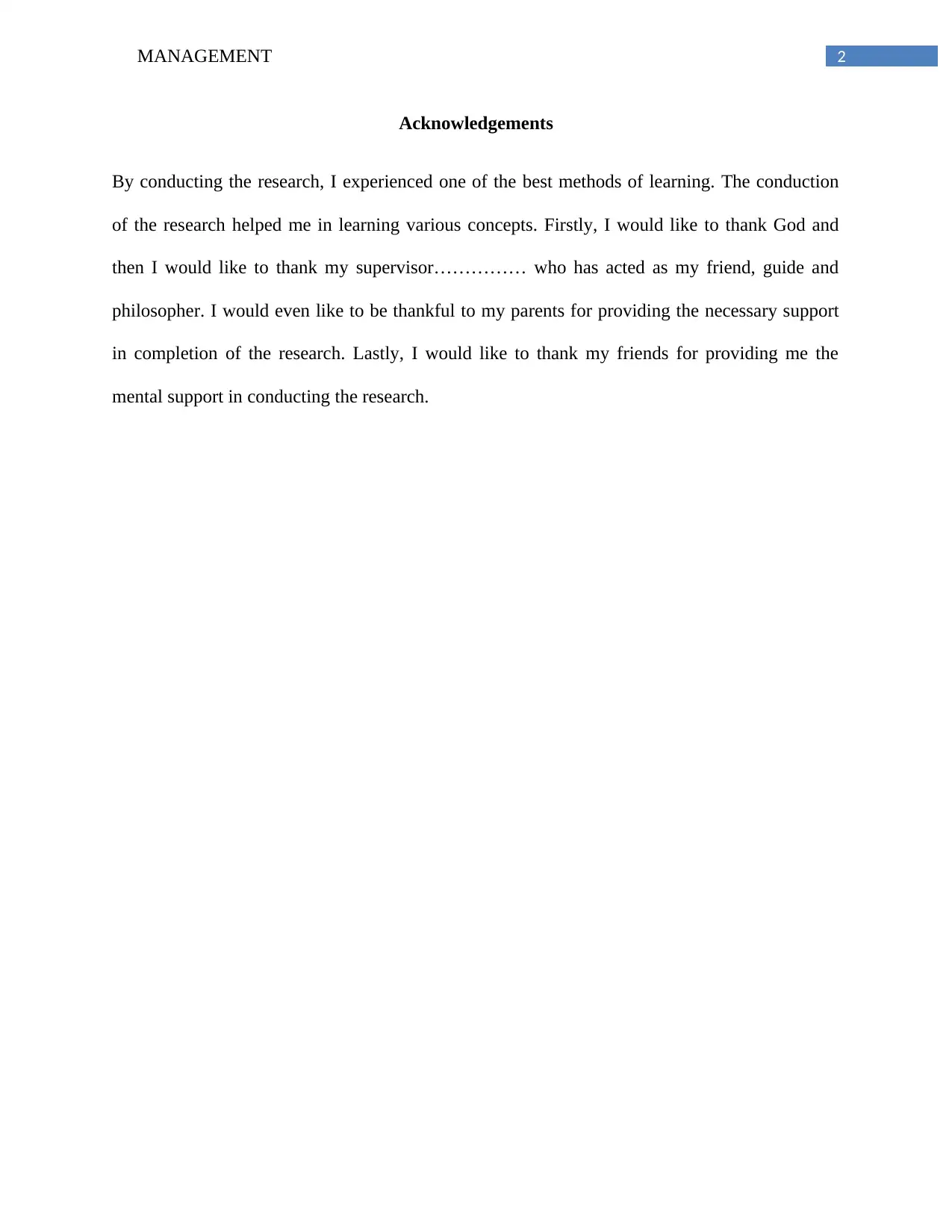
2MANAGEMENT
Acknowledgements
By conducting the research, I experienced one of the best methods of learning. The conduction
of the research helped me in learning various concepts. Firstly, I would like to thank God and
then I would like to thank my supervisor…………… who has acted as my friend, guide and
philosopher. I would even like to be thankful to my parents for providing the necessary support
in completion of the research. Lastly, I would like to thank my friends for providing me the
mental support in conducting the research.
Acknowledgements
By conducting the research, I experienced one of the best methods of learning. The conduction
of the research helped me in learning various concepts. Firstly, I would like to thank God and
then I would like to thank my supervisor…………… who has acted as my friend, guide and
philosopher. I would even like to be thankful to my parents for providing the necessary support
in completion of the research. Lastly, I would like to thank my friends for providing me the
mental support in conducting the research.
⊘ This is a preview!⊘
Do you want full access?
Subscribe today to unlock all pages.

Trusted by 1+ million students worldwide
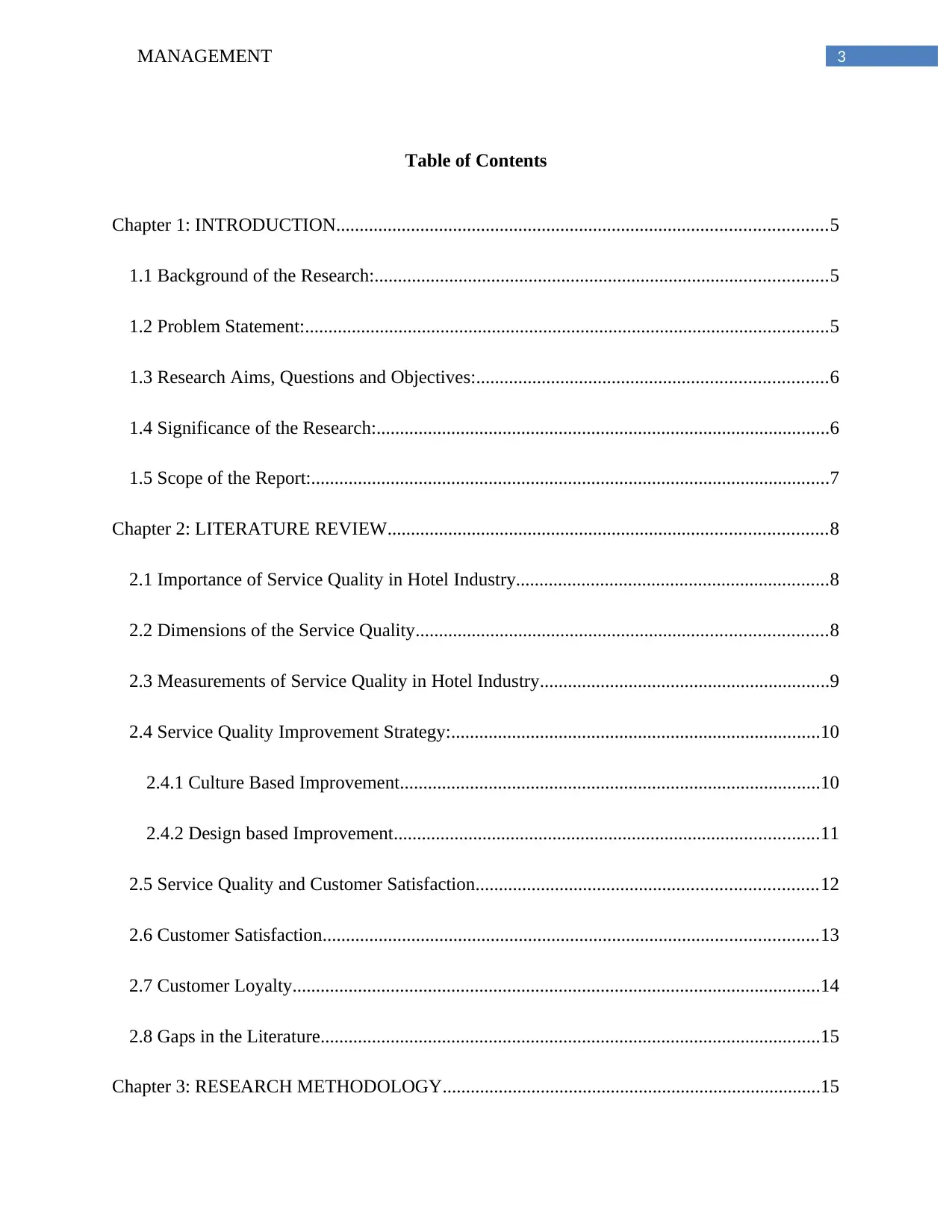
3MANAGEMENT
Table of Contents
Chapter 1: INTRODUCTION.........................................................................................................5
1.1 Background of the Research:.................................................................................................5
1.2 Problem Statement:................................................................................................................5
1.3 Research Aims, Questions and Objectives:...........................................................................6
1.4 Significance of the Research:.................................................................................................6
1.5 Scope of the Report:...............................................................................................................7
Chapter 2: LITERATURE REVIEW..............................................................................................8
2.1 Importance of Service Quality in Hotel Industry...................................................................8
2.2 Dimensions of the Service Quality........................................................................................8
2.3 Measurements of Service Quality in Hotel Industry..............................................................9
2.4 Service Quality Improvement Strategy:...............................................................................10
2.4.1 Culture Based Improvement..........................................................................................10
2.4.2 Design based Improvement...........................................................................................11
2.5 Service Quality and Customer Satisfaction.........................................................................12
2.6 Customer Satisfaction..........................................................................................................13
2.7 Customer Loyalty.................................................................................................................14
2.8 Gaps in the Literature...........................................................................................................15
Chapter 3: RESEARCH METHODOLOGY.................................................................................15
Table of Contents
Chapter 1: INTRODUCTION.........................................................................................................5
1.1 Background of the Research:.................................................................................................5
1.2 Problem Statement:................................................................................................................5
1.3 Research Aims, Questions and Objectives:...........................................................................6
1.4 Significance of the Research:.................................................................................................6
1.5 Scope of the Report:...............................................................................................................7
Chapter 2: LITERATURE REVIEW..............................................................................................8
2.1 Importance of Service Quality in Hotel Industry...................................................................8
2.2 Dimensions of the Service Quality........................................................................................8
2.3 Measurements of Service Quality in Hotel Industry..............................................................9
2.4 Service Quality Improvement Strategy:...............................................................................10
2.4.1 Culture Based Improvement..........................................................................................10
2.4.2 Design based Improvement...........................................................................................11
2.5 Service Quality and Customer Satisfaction.........................................................................12
2.6 Customer Satisfaction..........................................................................................................13
2.7 Customer Loyalty.................................................................................................................14
2.8 Gaps in the Literature...........................................................................................................15
Chapter 3: RESEARCH METHODOLOGY.................................................................................15
Paraphrase This Document
Need a fresh take? Get an instant paraphrase of this document with our AI Paraphraser
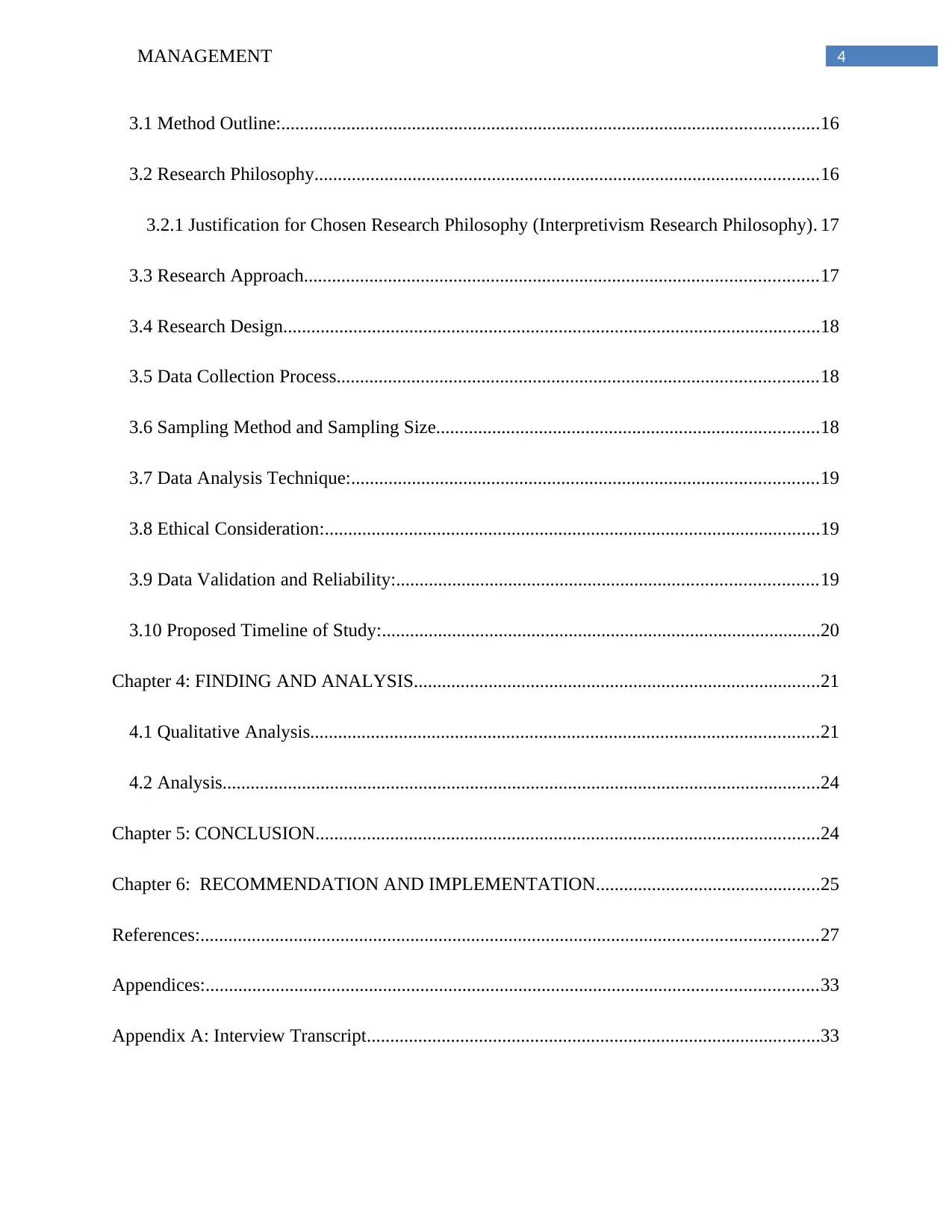
4MANAGEMENT
3.1 Method Outline:...................................................................................................................16
3.2 Research Philosophy............................................................................................................16
3.2.1 Justification for Chosen Research Philosophy (Interpretivism Research Philosophy). 17
3.3 Research Approach..............................................................................................................17
3.4 Research Design...................................................................................................................18
3.5 Data Collection Process.......................................................................................................18
3.6 Sampling Method and Sampling Size..................................................................................18
3.7 Data Analysis Technique:....................................................................................................19
3.8 Ethical Consideration:..........................................................................................................19
3.9 Data Validation and Reliability:..........................................................................................19
3.10 Proposed Timeline of Study:..............................................................................................20
Chapter 4: FINDING AND ANALYSIS.......................................................................................21
4.1 Qualitative Analysis.............................................................................................................21
4.2 Analysis................................................................................................................................24
Chapter 5: CONCLUSION............................................................................................................24
Chapter 6: RECOMMENDATION AND IMPLEMENTATION................................................25
References:....................................................................................................................................27
Appendices:...................................................................................................................................33
Appendix A: Interview Transcript.................................................................................................33
3.1 Method Outline:...................................................................................................................16
3.2 Research Philosophy............................................................................................................16
3.2.1 Justification for Chosen Research Philosophy (Interpretivism Research Philosophy). 17
3.3 Research Approach..............................................................................................................17
3.4 Research Design...................................................................................................................18
3.5 Data Collection Process.......................................................................................................18
3.6 Sampling Method and Sampling Size..................................................................................18
3.7 Data Analysis Technique:....................................................................................................19
3.8 Ethical Consideration:..........................................................................................................19
3.9 Data Validation and Reliability:..........................................................................................19
3.10 Proposed Timeline of Study:..............................................................................................20
Chapter 4: FINDING AND ANALYSIS.......................................................................................21
4.1 Qualitative Analysis.............................................................................................................21
4.2 Analysis................................................................................................................................24
Chapter 5: CONCLUSION............................................................................................................24
Chapter 6: RECOMMENDATION AND IMPLEMENTATION................................................25
References:....................................................................................................................................27
Appendices:...................................................................................................................................33
Appendix A: Interview Transcript.................................................................................................33

5MANAGEMENT
⊘ This is a preview!⊘
Do you want full access?
Subscribe today to unlock all pages.

Trusted by 1+ million students worldwide
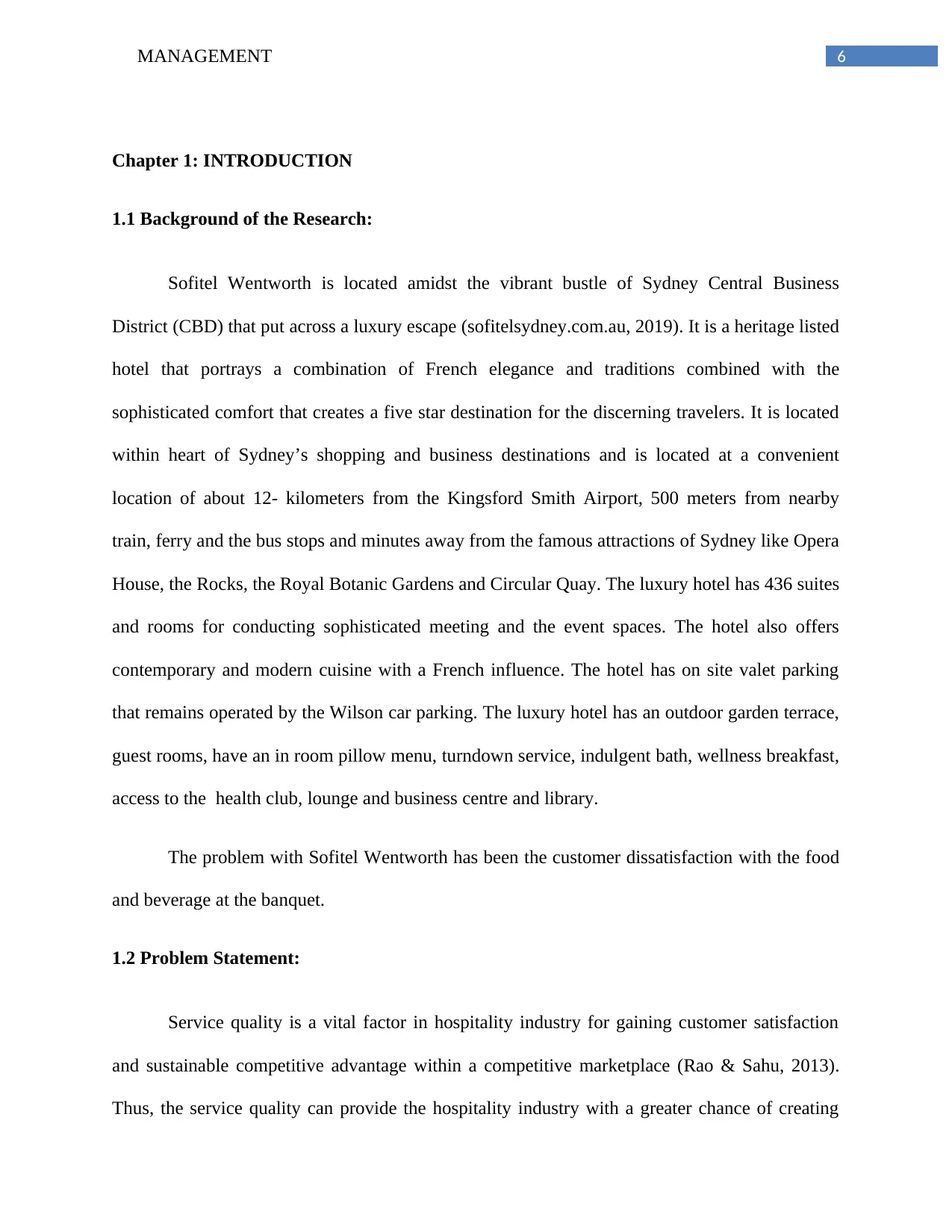
6MANAGEMENT
Chapter 1: INTRODUCTION
1.1 Background of the Research:
Sofitel Wentworth is located amidst the vibrant bustle of Sydney Central Business
District (CBD) that put across a luxury escape (sofitelsydney.com.au, 2019). It is a heritage listed
hotel that portrays a combination of French elegance and traditions combined with the
sophisticated comfort that creates a five star destination for the discerning travelers. It is located
within heart of Sydney’s shopping and business destinations and is located at a convenient
location of about 12- kilometers from the Kingsford Smith Airport, 500 meters from nearby
train, ferry and the bus stops and minutes away from the famous attractions of Sydney like Opera
House, the Rocks, the Royal Botanic Gardens and Circular Quay. The luxury hotel has 436 suites
and rooms for conducting sophisticated meeting and the event spaces. The hotel also offers
contemporary and modern cuisine with a French influence. The hotel has on site valet parking
that remains operated by the Wilson car parking. The luxury hotel has an outdoor garden terrace,
guest rooms, have an in room pillow menu, turndown service, indulgent bath, wellness breakfast,
access to the health club, lounge and business centre and library.
The problem with Sofitel Wentworth has been the customer dissatisfaction with the food
and beverage at the banquet.
1.2 Problem Statement:
Service quality is a vital factor in hospitality industry for gaining customer satisfaction
and sustainable competitive advantage within a competitive marketplace (Rao & Sahu, 2013).
Thus, the service quality can provide the hospitality industry with a greater chance of creating
Chapter 1: INTRODUCTION
1.1 Background of the Research:
Sofitel Wentworth is located amidst the vibrant bustle of Sydney Central Business
District (CBD) that put across a luxury escape (sofitelsydney.com.au, 2019). It is a heritage listed
hotel that portrays a combination of French elegance and traditions combined with the
sophisticated comfort that creates a five star destination for the discerning travelers. It is located
within heart of Sydney’s shopping and business destinations and is located at a convenient
location of about 12- kilometers from the Kingsford Smith Airport, 500 meters from nearby
train, ferry and the bus stops and minutes away from the famous attractions of Sydney like Opera
House, the Rocks, the Royal Botanic Gardens and Circular Quay. The luxury hotel has 436 suites
and rooms for conducting sophisticated meeting and the event spaces. The hotel also offers
contemporary and modern cuisine with a French influence. The hotel has on site valet parking
that remains operated by the Wilson car parking. The luxury hotel has an outdoor garden terrace,
guest rooms, have an in room pillow menu, turndown service, indulgent bath, wellness breakfast,
access to the health club, lounge and business centre and library.
The problem with Sofitel Wentworth has been the customer dissatisfaction with the food
and beverage at the banquet.
1.2 Problem Statement:
Service quality is a vital factor in hospitality industry for gaining customer satisfaction
and sustainable competitive advantage within a competitive marketplace (Rao & Sahu, 2013).
Thus, the service quality can provide the hospitality industry with a greater chance of creating
Paraphrase This Document
Need a fresh take? Get an instant paraphrase of this document with our AI Paraphraser
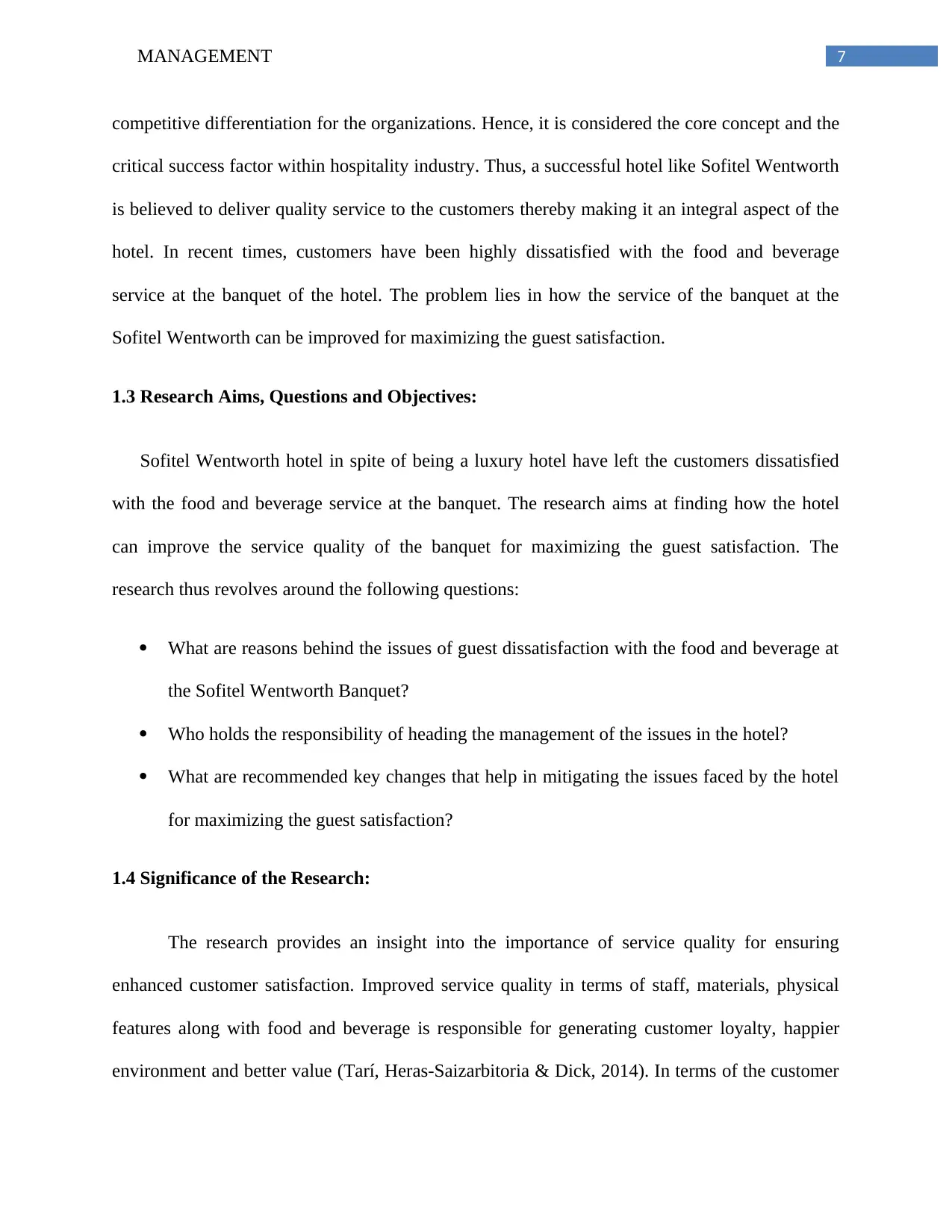
7MANAGEMENT
competitive differentiation for the organizations. Hence, it is considered the core concept and the
critical success factor within hospitality industry. Thus, a successful hotel like Sofitel Wentworth
is believed to deliver quality service to the customers thereby making it an integral aspect of the
hotel. In recent times, customers have been highly dissatisfied with the food and beverage
service at the banquet of the hotel. The problem lies in how the service of the banquet at the
Sofitel Wentworth can be improved for maximizing the guest satisfaction.
1.3 Research Aims, Questions and Objectives:
Sofitel Wentworth hotel in spite of being a luxury hotel have left the customers dissatisfied
with the food and beverage service at the banquet. The research aims at finding how the hotel
can improve the service quality of the banquet for maximizing the guest satisfaction. The
research thus revolves around the following questions:
What are reasons behind the issues of guest dissatisfaction with the food and beverage at
the Sofitel Wentworth Banquet?
Who holds the responsibility of heading the management of the issues in the hotel?
What are recommended key changes that help in mitigating the issues faced by the hotel
for maximizing the guest satisfaction?
1.4 Significance of the Research:
The research provides an insight into the importance of service quality for ensuring
enhanced customer satisfaction. Improved service quality in terms of staff, materials, physical
features along with food and beverage is responsible for generating customer loyalty, happier
environment and better value (Tarí, Heras-Saizarbitoria & Dick, 2014). In terms of the customer
competitive differentiation for the organizations. Hence, it is considered the core concept and the
critical success factor within hospitality industry. Thus, a successful hotel like Sofitel Wentworth
is believed to deliver quality service to the customers thereby making it an integral aspect of the
hotel. In recent times, customers have been highly dissatisfied with the food and beverage
service at the banquet of the hotel. The problem lies in how the service of the banquet at the
Sofitel Wentworth can be improved for maximizing the guest satisfaction.
1.3 Research Aims, Questions and Objectives:
Sofitel Wentworth hotel in spite of being a luxury hotel have left the customers dissatisfied
with the food and beverage service at the banquet. The research aims at finding how the hotel
can improve the service quality of the banquet for maximizing the guest satisfaction. The
research thus revolves around the following questions:
What are reasons behind the issues of guest dissatisfaction with the food and beverage at
the Sofitel Wentworth Banquet?
Who holds the responsibility of heading the management of the issues in the hotel?
What are recommended key changes that help in mitigating the issues faced by the hotel
for maximizing the guest satisfaction?
1.4 Significance of the Research:
The research provides an insight into the importance of service quality for ensuring
enhanced customer satisfaction. Improved service quality in terms of staff, materials, physical
features along with food and beverage is responsible for generating customer loyalty, happier
environment and better value (Tarí, Heras-Saizarbitoria & Dick, 2014). In terms of the customer
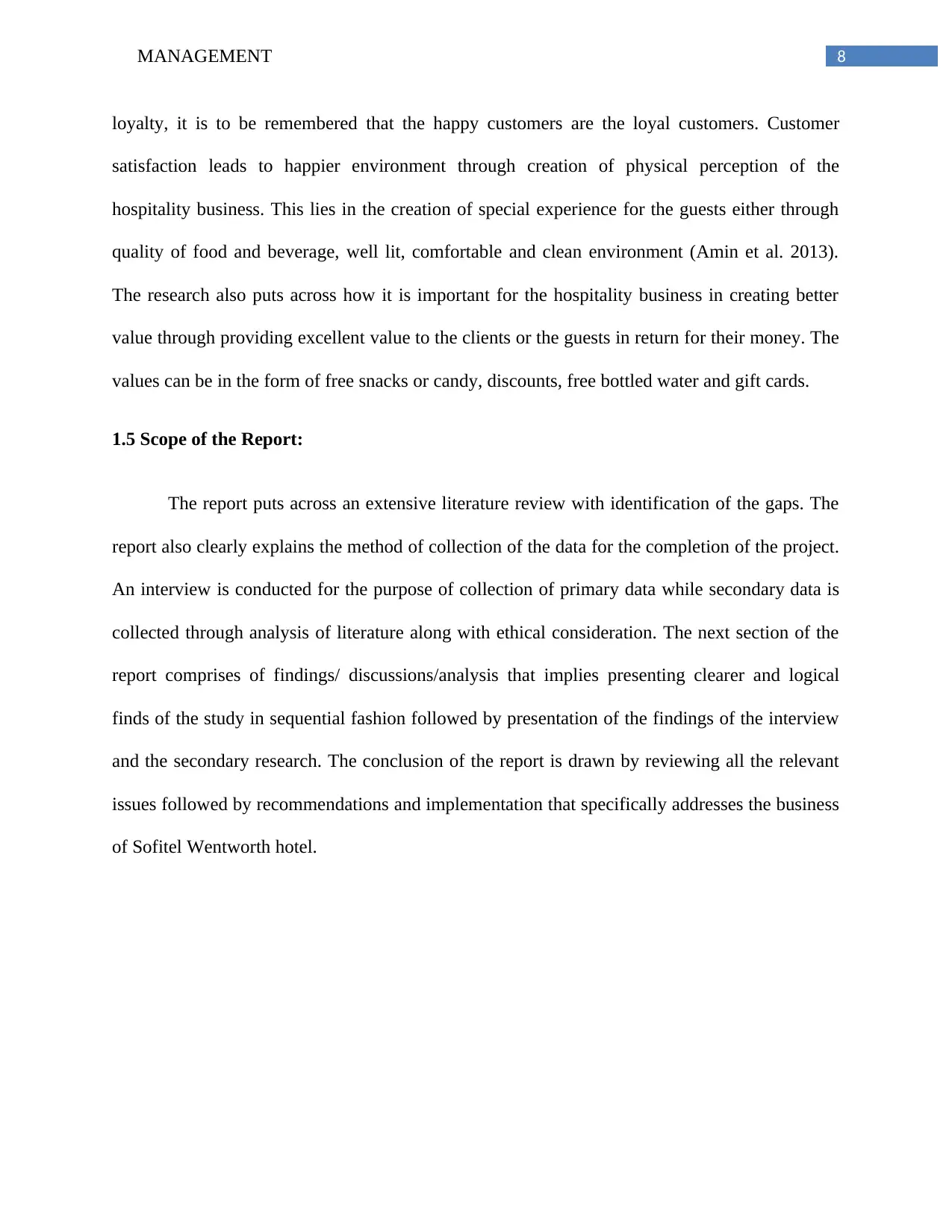
8MANAGEMENT
loyalty, it is to be remembered that the happy customers are the loyal customers. Customer
satisfaction leads to happier environment through creation of physical perception of the
hospitality business. This lies in the creation of special experience for the guests either through
quality of food and beverage, well lit, comfortable and clean environment (Amin et al. 2013).
The research also puts across how it is important for the hospitality business in creating better
value through providing excellent value to the clients or the guests in return for their money. The
values can be in the form of free snacks or candy, discounts, free bottled water and gift cards.
1.5 Scope of the Report:
The report puts across an extensive literature review with identification of the gaps. The
report also clearly explains the method of collection of the data for the completion of the project.
An interview is conducted for the purpose of collection of primary data while secondary data is
collected through analysis of literature along with ethical consideration. The next section of the
report comprises of findings/ discussions/analysis that implies presenting clearer and logical
finds of the study in sequential fashion followed by presentation of the findings of the interview
and the secondary research. The conclusion of the report is drawn by reviewing all the relevant
issues followed by recommendations and implementation that specifically addresses the business
of Sofitel Wentworth hotel.
loyalty, it is to be remembered that the happy customers are the loyal customers. Customer
satisfaction leads to happier environment through creation of physical perception of the
hospitality business. This lies in the creation of special experience for the guests either through
quality of food and beverage, well lit, comfortable and clean environment (Amin et al. 2013).
The research also puts across how it is important for the hospitality business in creating better
value through providing excellent value to the clients or the guests in return for their money. The
values can be in the form of free snacks or candy, discounts, free bottled water and gift cards.
1.5 Scope of the Report:
The report puts across an extensive literature review with identification of the gaps. The
report also clearly explains the method of collection of the data for the completion of the project.
An interview is conducted for the purpose of collection of primary data while secondary data is
collected through analysis of literature along with ethical consideration. The next section of the
report comprises of findings/ discussions/analysis that implies presenting clearer and logical
finds of the study in sequential fashion followed by presentation of the findings of the interview
and the secondary research. The conclusion of the report is drawn by reviewing all the relevant
issues followed by recommendations and implementation that specifically addresses the business
of Sofitel Wentworth hotel.
⊘ This is a preview!⊘
Do you want full access?
Subscribe today to unlock all pages.

Trusted by 1+ million students worldwide
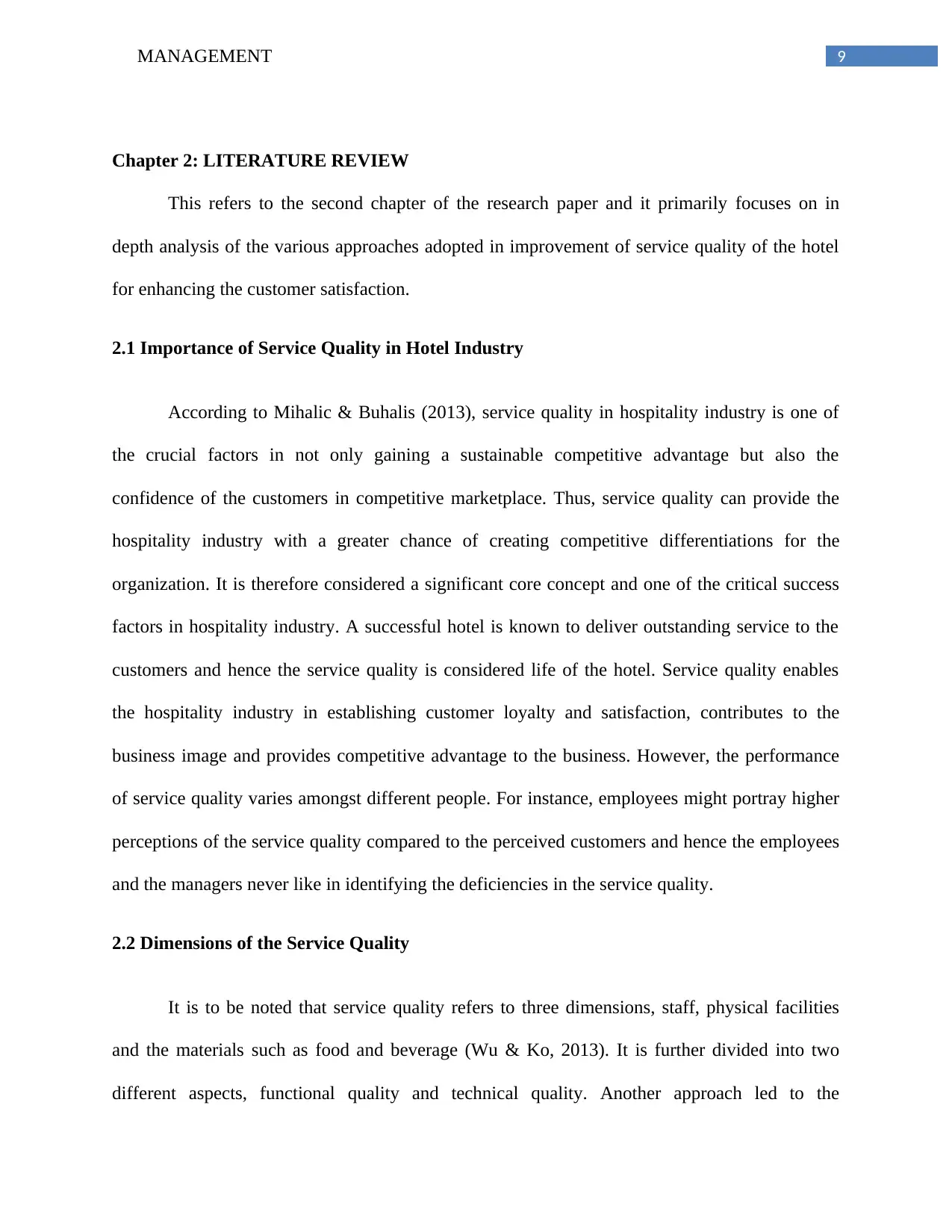
9MANAGEMENT
Chapter 2: LITERATURE REVIEW
This refers to the second chapter of the research paper and it primarily focuses on in
depth analysis of the various approaches adopted in improvement of service quality of the hotel
for enhancing the customer satisfaction.
2.1 Importance of Service Quality in Hotel Industry
According to Mihalic & Buhalis (2013), service quality in hospitality industry is one of
the crucial factors in not only gaining a sustainable competitive advantage but also the
confidence of the customers in competitive marketplace. Thus, service quality can provide the
hospitality industry with a greater chance of creating competitive differentiations for the
organization. It is therefore considered a significant core concept and one of the critical success
factors in hospitality industry. A successful hotel is known to deliver outstanding service to the
customers and hence the service quality is considered life of the hotel. Service quality enables
the hospitality industry in establishing customer loyalty and satisfaction, contributes to the
business image and provides competitive advantage to the business. However, the performance
of service quality varies amongst different people. For instance, employees might portray higher
perceptions of the service quality compared to the perceived customers and hence the employees
and the managers never like in identifying the deficiencies in the service quality.
2.2 Dimensions of the Service Quality
It is to be noted that service quality refers to three dimensions, staff, physical facilities
and the materials such as food and beverage (Wu & Ko, 2013). It is further divided into two
different aspects, functional quality and technical quality. Another approach led to the
Chapter 2: LITERATURE REVIEW
This refers to the second chapter of the research paper and it primarily focuses on in
depth analysis of the various approaches adopted in improvement of service quality of the hotel
for enhancing the customer satisfaction.
2.1 Importance of Service Quality in Hotel Industry
According to Mihalic & Buhalis (2013), service quality in hospitality industry is one of
the crucial factors in not only gaining a sustainable competitive advantage but also the
confidence of the customers in competitive marketplace. Thus, service quality can provide the
hospitality industry with a greater chance of creating competitive differentiations for the
organization. It is therefore considered a significant core concept and one of the critical success
factors in hospitality industry. A successful hotel is known to deliver outstanding service to the
customers and hence the service quality is considered life of the hotel. Service quality enables
the hospitality industry in establishing customer loyalty and satisfaction, contributes to the
business image and provides competitive advantage to the business. However, the performance
of service quality varies amongst different people. For instance, employees might portray higher
perceptions of the service quality compared to the perceived customers and hence the employees
and the managers never like in identifying the deficiencies in the service quality.
2.2 Dimensions of the Service Quality
It is to be noted that service quality refers to three dimensions, staff, physical facilities
and the materials such as food and beverage (Wu & Ko, 2013). It is further divided into two
different aspects, functional quality and technical quality. Another approach led to the
Paraphrase This Document
Need a fresh take? Get an instant paraphrase of this document with our AI Paraphraser
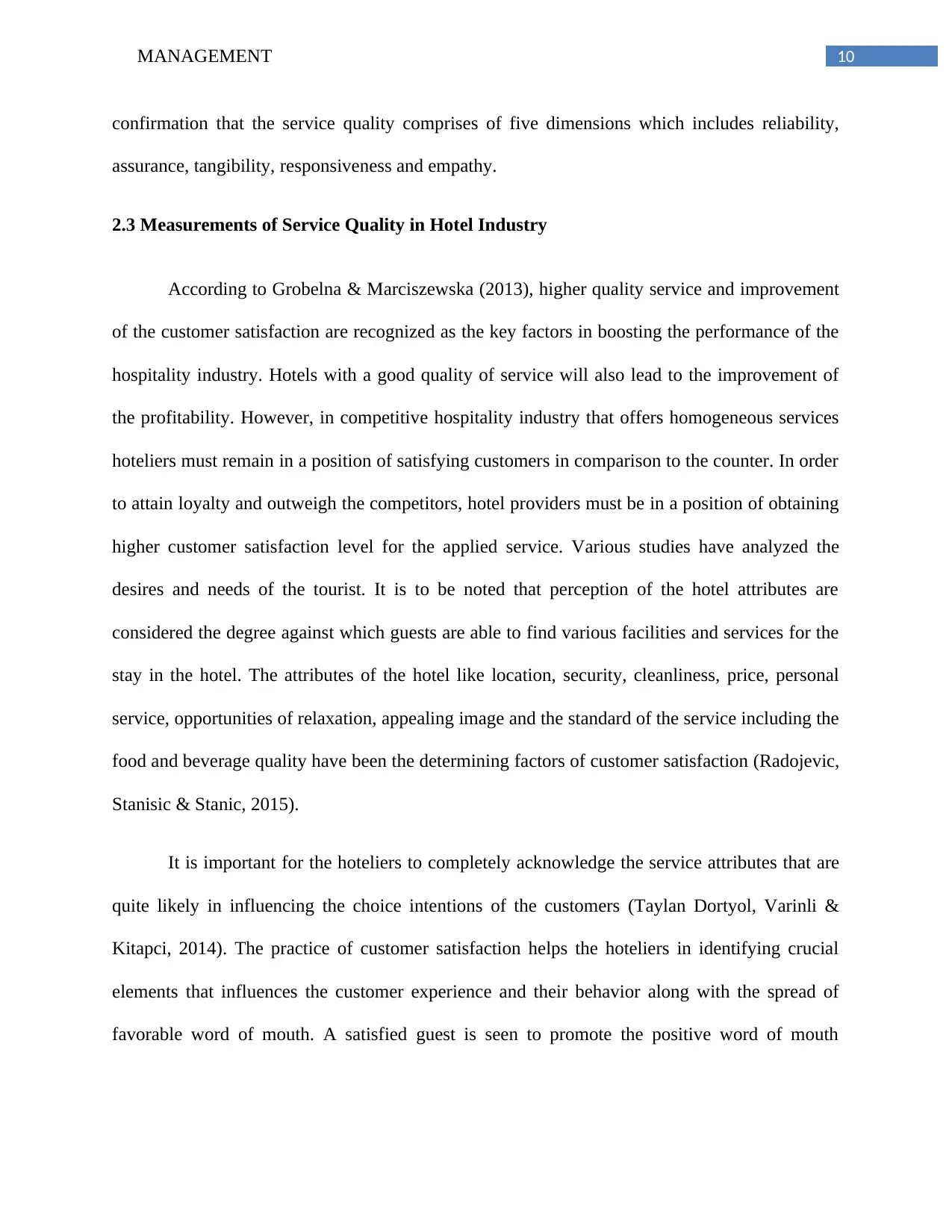
10MANAGEMENT
confirmation that the service quality comprises of five dimensions which includes reliability,
assurance, tangibility, responsiveness and empathy.
2.3 Measurements of Service Quality in Hotel Industry
According to Grobelna & Marciszewska (2013), higher quality service and improvement
of the customer satisfaction are recognized as the key factors in boosting the performance of the
hospitality industry. Hotels with a good quality of service will also lead to the improvement of
the profitability. However, in competitive hospitality industry that offers homogeneous services
hoteliers must remain in a position of satisfying customers in comparison to the counter. In order
to attain loyalty and outweigh the competitors, hotel providers must be in a position of obtaining
higher customer satisfaction level for the applied service. Various studies have analyzed the
desires and needs of the tourist. It is to be noted that perception of the hotel attributes are
considered the degree against which guests are able to find various facilities and services for the
stay in the hotel. The attributes of the hotel like location, security, cleanliness, price, personal
service, opportunities of relaxation, appealing image and the standard of the service including the
food and beverage quality have been the determining factors of customer satisfaction (Radojevic,
Stanisic & Stanic, 2015).
It is important for the hoteliers to completely acknowledge the service attributes that are
quite likely in influencing the choice intentions of the customers (Taylan Dortyol, Varinli &
Kitapci, 2014). The practice of customer satisfaction helps the hoteliers in identifying crucial
elements that influences the customer experience and their behavior along with the spread of
favorable word of mouth. A satisfied guest is seen to promote the positive word of mouth
confirmation that the service quality comprises of five dimensions which includes reliability,
assurance, tangibility, responsiveness and empathy.
2.3 Measurements of Service Quality in Hotel Industry
According to Grobelna & Marciszewska (2013), higher quality service and improvement
of the customer satisfaction are recognized as the key factors in boosting the performance of the
hospitality industry. Hotels with a good quality of service will also lead to the improvement of
the profitability. However, in competitive hospitality industry that offers homogeneous services
hoteliers must remain in a position of satisfying customers in comparison to the counter. In order
to attain loyalty and outweigh the competitors, hotel providers must be in a position of obtaining
higher customer satisfaction level for the applied service. Various studies have analyzed the
desires and needs of the tourist. It is to be noted that perception of the hotel attributes are
considered the degree against which guests are able to find various facilities and services for the
stay in the hotel. The attributes of the hotel like location, security, cleanliness, price, personal
service, opportunities of relaxation, appealing image and the standard of the service including the
food and beverage quality have been the determining factors of customer satisfaction (Radojevic,
Stanisic & Stanic, 2015).
It is important for the hoteliers to completely acknowledge the service attributes that are
quite likely in influencing the choice intentions of the customers (Taylan Dortyol, Varinli &
Kitapci, 2014). The practice of customer satisfaction helps the hoteliers in identifying crucial
elements that influences the customer experience and their behavior along with the spread of
favorable word of mouth. A satisfied guest is seen to promote the positive word of mouth
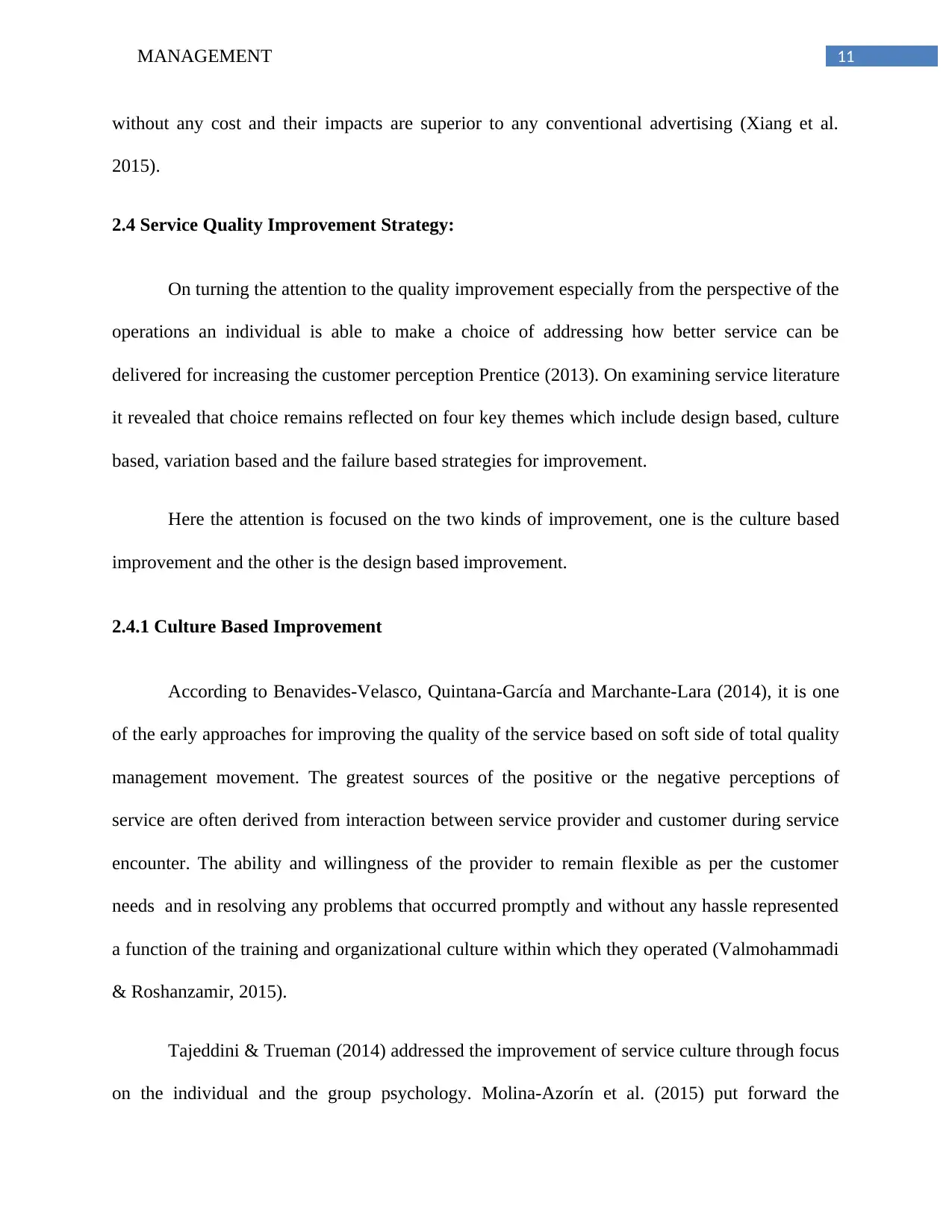
11MANAGEMENT
without any cost and their impacts are superior to any conventional advertising (Xiang et al.
2015).
2.4 Service Quality Improvement Strategy:
On turning the attention to the quality improvement especially from the perspective of the
operations an individual is able to make a choice of addressing how better service can be
delivered for increasing the customer perception Prentice (2013). On examining service literature
it revealed that choice remains reflected on four key themes which include design based, culture
based, variation based and the failure based strategies for improvement.
Here the attention is focused on the two kinds of improvement, one is the culture based
improvement and the other is the design based improvement.
2.4.1 Culture Based Improvement
According to Benavides-Velasco, Quintana-García and Marchante-Lara (2014), it is one
of the early approaches for improving the quality of the service based on soft side of total quality
management movement. The greatest sources of the positive or the negative perceptions of
service are often derived from interaction between service provider and customer during service
encounter. The ability and willingness of the provider to remain flexible as per the customer
needs and in resolving any problems that occurred promptly and without any hassle represented
a function of the training and organizational culture within which they operated (Valmohammadi
& Roshanzamir, 2015).
Tajeddini & Trueman (2014) addressed the improvement of service culture through focus
on the individual and the group psychology. Molina-Azorín et al. (2015) put forward the
without any cost and their impacts are superior to any conventional advertising (Xiang et al.
2015).
2.4 Service Quality Improvement Strategy:
On turning the attention to the quality improvement especially from the perspective of the
operations an individual is able to make a choice of addressing how better service can be
delivered for increasing the customer perception Prentice (2013). On examining service literature
it revealed that choice remains reflected on four key themes which include design based, culture
based, variation based and the failure based strategies for improvement.
Here the attention is focused on the two kinds of improvement, one is the culture based
improvement and the other is the design based improvement.
2.4.1 Culture Based Improvement
According to Benavides-Velasco, Quintana-García and Marchante-Lara (2014), it is one
of the early approaches for improving the quality of the service based on soft side of total quality
management movement. The greatest sources of the positive or the negative perceptions of
service are often derived from interaction between service provider and customer during service
encounter. The ability and willingness of the provider to remain flexible as per the customer
needs and in resolving any problems that occurred promptly and without any hassle represented
a function of the training and organizational culture within which they operated (Valmohammadi
& Roshanzamir, 2015).
Tajeddini & Trueman (2014) addressed the improvement of service culture through focus
on the individual and the group psychology. Molina-Azorín et al. (2015) put forward the
⊘ This is a preview!⊘
Do you want full access?
Subscribe today to unlock all pages.

Trusted by 1+ million students worldwide
1 out of 36
Related Documents
Your All-in-One AI-Powered Toolkit for Academic Success.
+13062052269
info@desklib.com
Available 24*7 on WhatsApp / Email
![[object Object]](/_next/static/media/star-bottom.7253800d.svg)
Unlock your academic potential
Copyright © 2020–2025 A2Z Services. All Rights Reserved. Developed and managed by ZUCOL.





